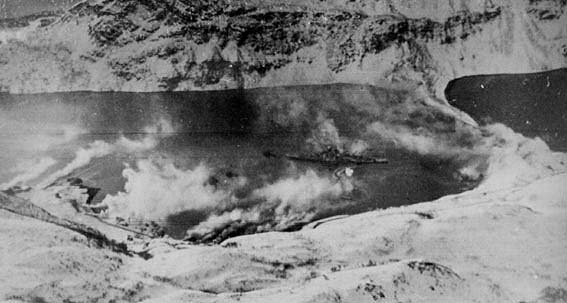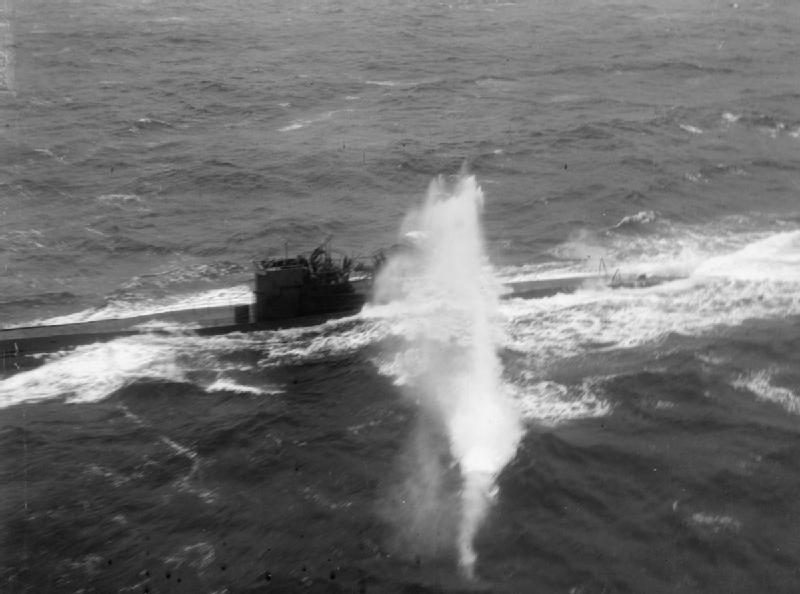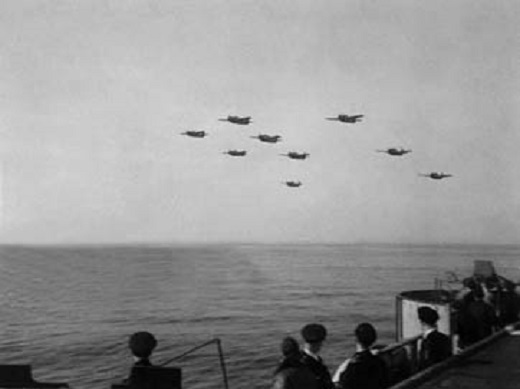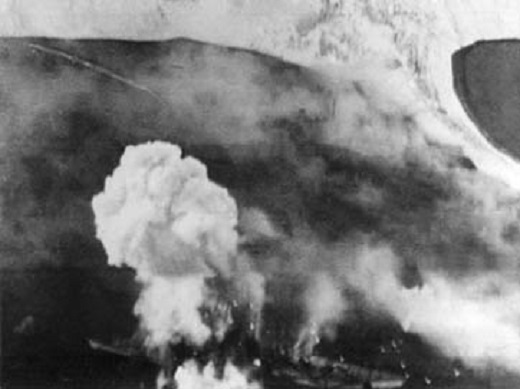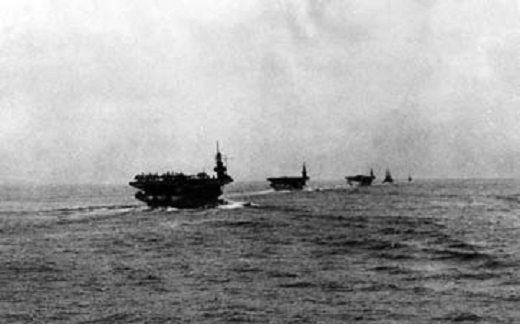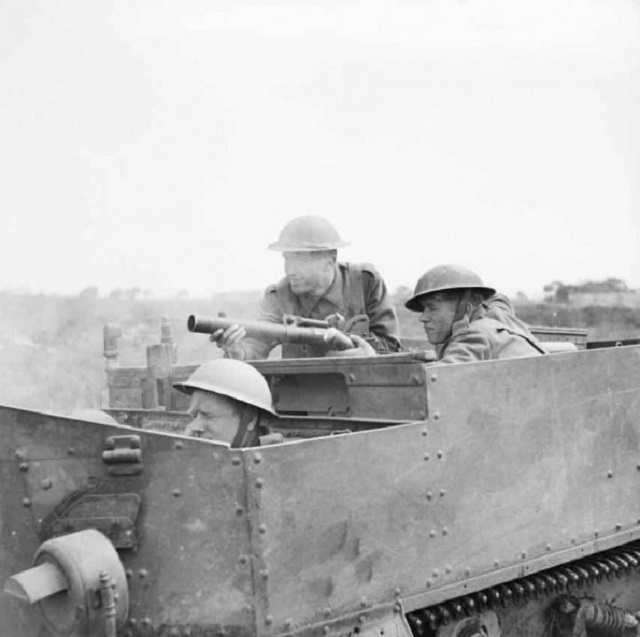Admiralty Islands
The 2nd Squadron, 12th Cavarly, lands without opposition on Rambutyo Island, after a preparatory bombardment and begins the search for the few Japanese concealed there.
[Air Operations, Carolines
- 41st Medium Bomb Group B-25s attack Ponape Island.
- During the night, 20 VII Bomber Command B-24s attack the Truk Atoll.
- 2 B-24s are lost.
Air Operations, CBI
BURMA- 6 490th Medium Bomb Squadron B-25s and more than 2 10th Air Force fighter-bombers attack Japanese Army ground troops near Bhamo, a bridge near Mogaung, and targets of opportunity near Mupaw Ga. 4 B-25s attack a bridge at Tangon. 36 10th Air Force A-31s attack Japanese Army ground troops along the upper Chindwin River. 6 P-51s attack the airfield at Anisakan. 8 459th Fighter Squadron P-38s attack the airfield at Meiktila.
- During the night, 16 7th Heavy Bomb Group B-24s attack fuel facilities and power plants at Chauk, Lanywa, and Yenangyaung.
- 4 14th Air Force P-40s armed with aerial rockets attack 2 large riverboats on the Yangtze River between Hengyang and Ichang.
- 3 308th Heavy Bomb Group B-24s sow mines in Haiphong harbor. 4 rocket-armed 14th Air Force P-40s attack small craft in the Red River.
Air Operations, East Indies
V Bomber Command B-25s attack Penfoei, Timor.
[Air Operations, Europe
US and RAF bombers begin bombing Budapest and other Hungarian cities ending the August 1943 agreement to refrain from such attacks in exchange for free and safe access over Hungary. Germans, not Hungarians, now man the aerial defenses in Hungary. 1,100 tons of bombs are dropped on Budapest rail targets and industrial sections by B-17s and B-24s of the 15th Air Force. There is strong fighter opposition. During the night the RAF follow up with a raid by Liberators and Wellingtons. The attacks necessitate a closure of all the city's stations and a large-scale evacuation of civilians which begins on April 7.
US 12th AIR FORCEITALY:
- 12th Air Force medium bombers cut the approaches to a bridge north of Orvieto.
- XII Air Support Command A-20s attack an ammo dump.
- XII Air Support Command A-36s attack a rail line and an underpass.
- XII Air Support Command P-40s attack the town area at Itri, a Germany Army bivouac, a railroad station, and a supply dump.
- XII Air Support Command P-47s attack a road junction and a town area.
HUNGARY:
- 15th Air Force B-24s attack marshalling yards at Budapest, and 15th Air Force B-17s attack Budapest's Csepel Island aircraft plant. P-38 pilots of the 1st, 14th, and 82nd Fighter Groups down 7 Luftwaffe fighters and 2 He-111s in the Budapest area between 1020 and 1105 hours.
- 15th Air Force B-24s attack a marshalling yard at Brod.
Air Operations, New Guinea
- In the 5th Air Force’s heaviest attack to date against Hollandia, 63 43rd and 90th Heavy Bomb Group B-24s, 96 3rd and 312th Light Bomb group A-20s, 76 38th and 345th Medium Bomb group B-25s, and many V Fighter Command P-38 long-range fighter-bombers attack airfields and antiaircraft batteries in the Hollandia area. 1 P-38 is lost. This attack, coupled with those on March 30 and 31, breaks the back of the Japanese air forces in New Guinea. In these and several subsequent attacks in April, 340 Japanese aircraft are destroyed on the ground (and later hand-counted) and an estimated 60 Japanese fighters are shot down. USAAF losses in direct combat during these attacks amount to 2 P-38s and 1 B-24 shot down and 1 shot-up F-7 lost in a bad landing. Little known beyond those who took part, this is one of the great aerial victories of World War II.
- V Bomber Command B-24s attack Langgoer. B-25s attack the Babo area. More than 50 V Fighter Command fighters and fighter-bombers attack occupied villages, communications targets, and antiaircraft batteries at Bogia, Hansa Bay, Madang, and Wewak.
- 8th Fighter Group P-38s and 348th Fighter Group P-47s down 25 Japanese fighters over the Hollandia area between 1050 hours and noon.
Air Operations, Pacific
Aircraft of the US 5th Air Force carry out the heaviest raid on the Japanese base at Hollandia since the offensive began. Since March 30 at least 300 Japanese aircraft have been destroyed either on the ground or in the air. By now enemy resistance in this sector has become insignificant.
[Arctic
- The Tirpitz is attacked and damaged in Alta Fjord (Antenfjord) by FAA Fairey Barracuda bombers from the carriers of the British Home Fleet. There are 438 German casualties. 4 aircraft are lost but the Tirpitz is put out of action for a further 3 months. The Victorious and Furious and 4 escort carriers are involved.
- U-288 working in the area of convoy JW-58 is attacked by Swordfish 'C' of 819 NAS of the British escort carrier Activity and Avengers 'G' and 'Y' of 826 NAS of the British escort carrier Tracker. After all three aircraft make attacks, the U-boat sinks horizontally before reappearing and sinking once again, leaving wreckage on the surface.
| Class | Type VIIC |
| CO | Oberleutnant zur See Willi Meyer |
| Location | Arctic, N of North Cape |
| Cause | Air attack |
| Casualties | 49 |
| Survivors | None |
CBI
BURMAEfforts by the US 5307th Unit (Merrill's Marauders), supported by aircraft and artillery, to free the 2nd Battalion surrounded by the Japanese in the Nhpum Ga area are abortive. The 1st Battalion is directed to move as quickly as possible to Hsamshingyang.
CHINAPresident Roosevelt appeals to Generalissimo Chiang Kai-shek to move Y Force against the Japanese holding the Burma Road in Yunnan province. The request is backed up with a threat to divert all supplies to the 14th Air Force. Chiang accepts and orders the Y Force of six armies (16 infantry divisions total) to join the offensive.
INDIAUpon meeting with Mountbatten and Gen Slim at Jorhat, Stilwell learn he is to continue with local offensives against the Japanese in the northeast, in spite of the serious situation in the Imphal-Kohima and Arakan areas. The capture of Myitkyina, in the north, would actually be of the first importance for the reopening, sooner or later, of the road between India and China. The Chindits, Indian 3rd Divison, will send 2 brigades to assist the Chinese and Americans in their offensive against Myitkyina.
[[
Eastern Front
SOUTHERN SECTORBitter fighting continues at Tarnopol as the 1st Guards Army tries to crush the last pockets of resistance inside the town.
With sleet falling, the 8th Guards Army of the 3rd Ukrainian Front launches an unexpected attack upon the 6th Army, pushing it back toward Odessa.
[Pacific
The US submarine Pollack (SS-180) attacks a Japanese convoy about 325 miles south of Yokohama, Japan and sinks the army cargo ship Tosei Maru (2814t).
[United States, Home Front
The Supreme Court rules that Negroes have the right to vote in Texas.
[Images from April 3, 1944
|
|
|
|
|
|
Leading the First Attack on Tirpitz |
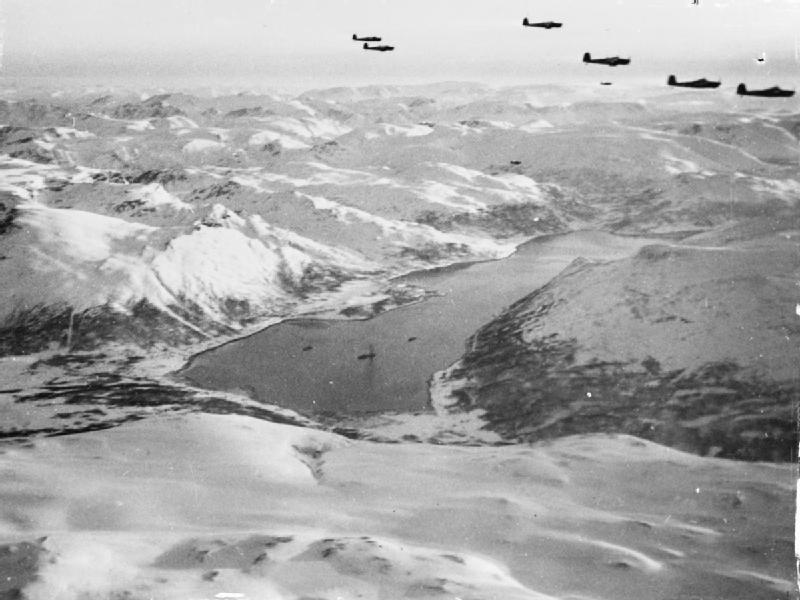 |
